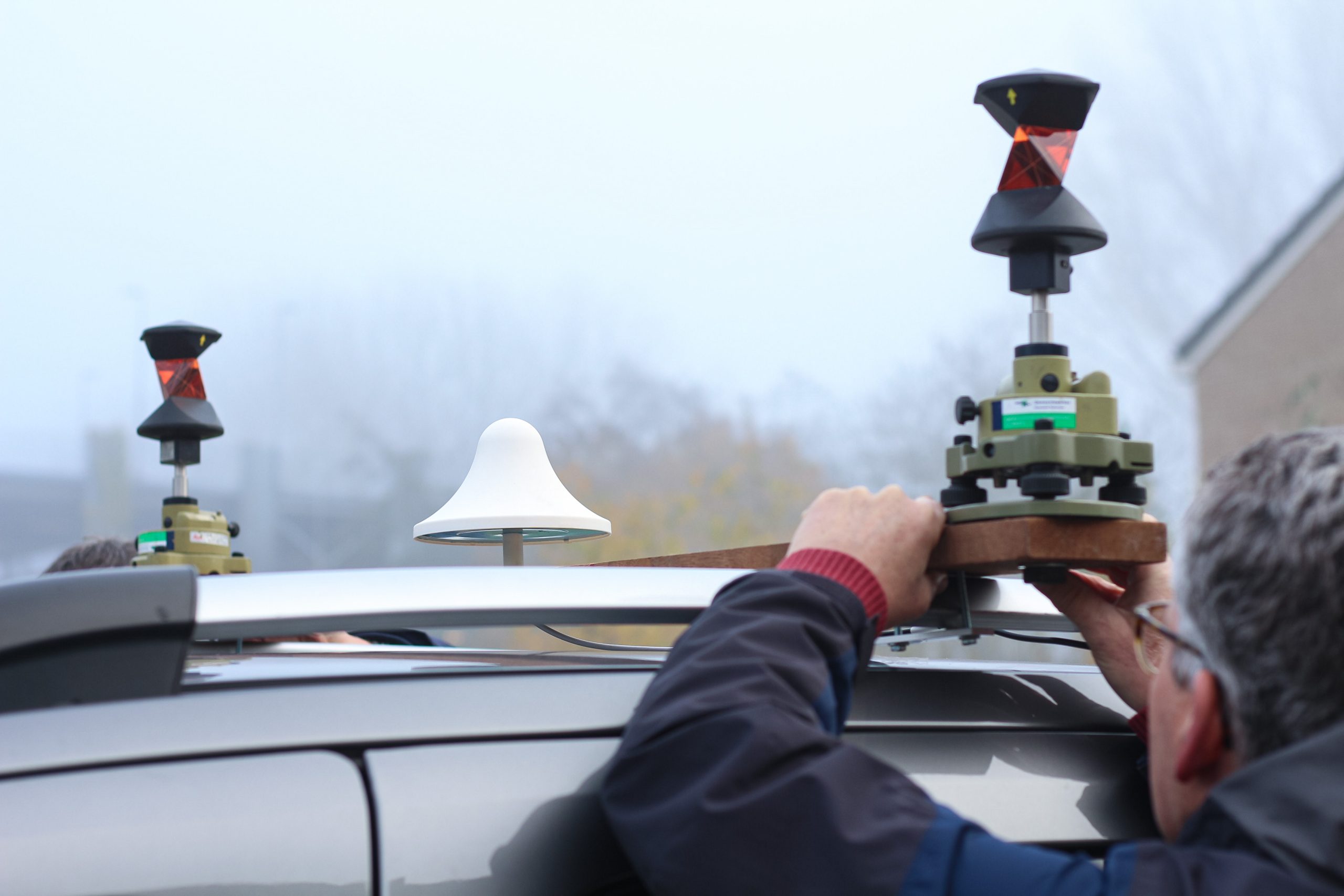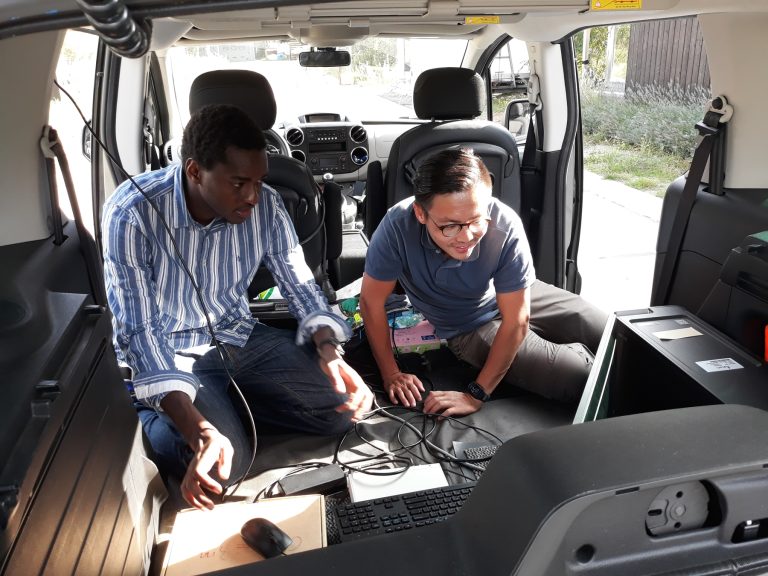The positioning of the current type of GPS sometimes deviates from the real location by metres. Positioning using 5G can change this, say TU Delft scientists in Nature.
Researchers Christian Tiberius (left) and Gerard Janssen (right) at the test setup on The Green Village (photo: Justyna Botor).
It is a familiar problem: your location on your telephone sometimes deviates by a couple of metres from your actual location, especially in crowded urban areas. This can be dangerous when self-driving cars drive in the wrong place because of a disrupted GPS signal, says Christian Tiberius. He, an Associate Professor in Geoscience and Remote Sensing at the Faculty of CEG, is researching global positioning systems (GPS). “If the position is a couple of metres out, you can be put in danger. One example is cars that think they are driving in a different lane than they actually are and then wrongly correct themselves.”
Tiberius is thus working with Gerard Janssen, Associate Professor of Circuits and Systems at EEMCS, and Physicist Jeroen Koelemeij, on an alternative to the current system: SuperGPS. The system works with a signal that is comparable to that of 5G masts, known for mobile internet on telephones. This makes the positioning more accurate – to within a few decimetres – than with the usual GPS systems which can be out by 20 metres.
Reflections
There are a few explanations for the inaccuracies of standard GPS systems. One is reflection, says Tiberius. “A signal going from a satellite to your telephone bangs against concrete and glass. This makes it bounce back.” This explains why the signal’s journey is longer than it should be. As the travel time of the signal is used to calculate the distance from the satellite to the telephone, it can go wrong. This then means that your location may be wrong.


One of the places where this happens is on the Utrechtsebaan motorway in The Hague, says Tiberius. “It is a sunken road in a concrete container and thus echoes the GPS signals.” Another example is the Weena road in Rotterdam which is also sunken. “I recently did some measuring there,” says Tiberius. “While I drove straight on in my lane, my location suddenly shifted by two lanes.”
Though the 5G mast signals can also reflect, the new 5G signals have fewer problems. This is because the reflected signals are easier to filter out, says his colleague Gerard Janssen. “Reflections are problematic if the signal with a reflected version of the same signal overlaps. Your telephone is unable to distinguish between one peak and the other, and estimates the distance wrongly.” This usually happens when a signal is on for a long time, such as with satellite GPS. As the 5G signal is shorter, the chance that there will be overlapping signals, and thus a wrong positioning, is smaller.
Atomic clock
What is important for accurate positioning is that all masts are synchronised precisely. Any small time deviation can cause the distance to the mast to be miscalculated, thereby giving a wrong position again. As the signal from the mast travels at the speed of light to the receiver, a delay of only one nanosecond can give an error of 30 centimetres in the positioning.
“The time should thus be recorded using an atomic clock,” says Tiberius. “The clock may be far away, but the signal is sent to the masts through fibreglass cables.” This is more reliable than sending the time through radio signals, as is done with satellites. There is a big advantage here: fibreglass cables are already connected to the 5G masts.
Hacking
Another advantage is that the signal from the 5G masts is stronger than that of satellites. Masts are closer together and send signals from the earth’s surface, says Tiberius. “Satellites are thousands of kilometres away from us. They sometimes have problems with solar storms too when charged particles are emitted by the sun. These particles sometimes end up in the ionosphere, a few hundred kilometres above the earth’s surface, where they disrupt the GPS signal.”


The 5G signals are more complex than satellite signals, making it harder to imitate and hack. That the hacking of GPS signals is a realistic risk is demonstrated in a film that Tiberius shows. By intercepting and adjusting the satellite signal, a Tesla can be ‘told’ that it is not driving along a polder road, but that it is driving on the motorway next to the road. This makes the car think that it needs to drive faster and that when overtaking, it only needs to take the cars driving behind it into account rather than any oncoming vehicles.
It may sound like science fiction, but this type of car hacking could happen, believes Tiberius. “If you invest a couple of thousand euros in a radio system, and put a couple of brilliant students to work on it, this could happen. And of course it is illegal.”
Pioneering
The GPS research is so pioneering that it resulted in a publication in Nature. Peer researchers at the University of Gothenburg in Sweden responded with enthusiasm, in part because of the relatively easy applicability. “5G masts are already there,” says Janssen, “and you can easily piggyback on the signals that mobile phone providers emit. Some of the usable signals are already being emitted.”
What the signal will be like in the end is part of a second piece of research that will start in 2023. “In any case, the signal may not overlap with the mobile data that the masts are currently emitting,” says Tiberius. “So we cannot use masts’ entire bandwidth.”
Black magic
This is not really necessary anyway. “Even if we only use a couple of small pieces of the whole broadband, we will still hardly compromise the accuracy of the GPS,” says Tiberius. “And we are not in the way of the providers.” How this exactly works is a bit like black magic, he laughs. “It is quite complicated. But look at it like this: if you only use 2% of the whole bandwidth, you will still be obtaining 98% accuracy. This is more than enough.”
There are enough applications that need an extremely accurate positioning system. Not only can it make self-driving cars significantly safer, but it brings the delivery of packages by drones a step closer. And by connecting transmission towers to an atomic clock, a timestamp can be issued to money transactions on your phone which will protect them from changes made by criminals.
Mobile providers are very interested in any case, says Tiberius. “KPN has taken over two of our patents for further development. And they are working with us on our continued research.”
Do you have a question or comment about this article?
K.S.vanderWal@tudelft.nl


Comments are closed.